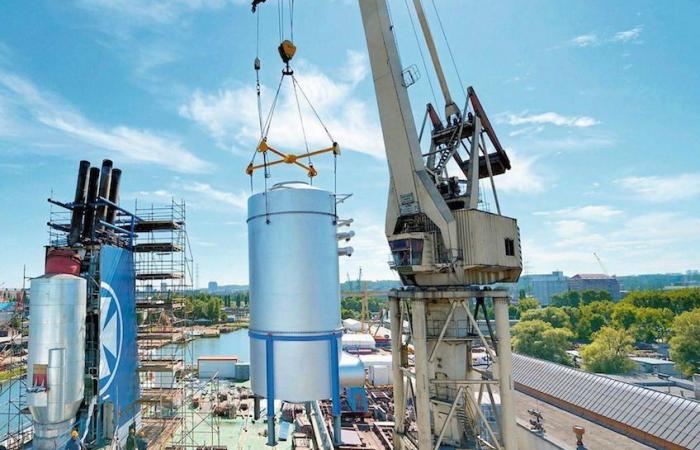More than 40% of the world’s container ship fleet is now equipped with controversial devices which, by treating gases leaving the chimneys, maintain the use of heavy fuel oil. The price gap between low and high sulfur fuels favors scrubbers.
The new generation of fuel ships with radically or partially green fuels is taking center stage. However, another, more underground reality is emerging. As of September 6, there were, according to Alphaliner calculations, 1,353 container ships equipped with scrubbers (Exhaust Gas Cleaning, EGC), these devices which allow exhaust gases to be purified like catalytic converters. on cars and address SOx (sulfur dioxide) emissions in accordance with IMO2020 regulations. Totaling a capacity of 12.4 MEVP, the share of equipped vessels represents 41.1% of the current fleet. The equipment rate was around 11% when fuel sulfur regulations were introduced in 2020, 32% at the end of 2022 and 36% at the end of 2023. But it has not It only took eight months to achieve a further increase of 5%, and this on a fleet whose new build deliveries have exploded this year.
Favorable gap between different fuels
The phenomenon is explained by the good direction of fuel prices. The price delta between HFO (fuel with 3% sulfur content) and VLSFO (sulfur content with 0.5% sulfur or less), averaged $91 per tonne (Rotterdam) between January and May compared to $101 in 2023. It widened with the recovery of the barrel of Brent during the summer and would be closer to $110. In comparison, the average was $219 in 2022 and $110 in 2021. But in one year, from September to September, the IFO 380 went from $596 to $423 per ton and the VLSFO, from 628 to 507 $.
The price gap between the two types of fuel – called the Hi5 gap – is a key indicator determining interest in this technology. The lower it is, the more the arguments in favor of installing scrubbers lose their relevance because the amortization period for the installation cost (between $2 and $5 million depending on the type of ship) is lengthened. . When it is significant, the return on investment is short and ships equipped with scrubbers save on fuel bills.
The situation has recently improved for equipment manufacturers (Wärtsilä, Alfa Laval, etc.) after a long decline between mid-2022 and autumn 2023. The massive diversion of the Suez Canal container ship fleet to the Cape of Good Hope, which extends ton-miles, is another argument in their favor.
MSC in the lead
The incredible expansion of MSC’s fleet (562 owned) has caused the equipment rate of its fleet to explode to 54% in January 2024 compared to 46% two years previously. The world leader in regular shipping has never hidden its preference for purification systems. However, it is far from HMM and Evergreen who are big fans, whose penetration rate is 84 and 83% respectively. But on its own, it had contributed 890,000 TEUs at the end of January to the capacity equipped at the global level (12 MEVP therefore).
In addition to MSC, among the armaments whose battalion has increased the most are Hapag-Lloyd (+ 8%), ONE and Cosco, each by more than 7%. The Japanese thus has 33% of its units underway, or 40 ships and 600,000 TEUs in one year. However, the company was very skeptical of the technology and the only one among the ten world leaders that did not take the plunge when sulfur capping regulations came into force in 2020.
Aversion of Cosco and CMA CGM
Cosco’s aversion has remained marked: although its fleet (195 vessels currently owned) equipped with EGC has increased from 12 to 19%, it remains the most resistant to the solution with CMA CGM (26%). , whose equipment rate had barely changed in one year. A data to be compared with its 44 LNG vessels.
Still atypical, the Israeli carrier, which has only nine ships totaling 70,000 TEU with scrubbers. Like CMA CGM, most of its charter deliveries will be powered by LNG, with the exception of 12 vessels, the solutions for which are not known.
As for the tankers, whose order book currently stands at 201 units, they will burn 59% HFO (IFO 380) as their main fuel and will be equipped with scrubbers. Among the ships running on HFO, 44% will be configured for LNG, methanol or ammonia.
Adeline Descamps






